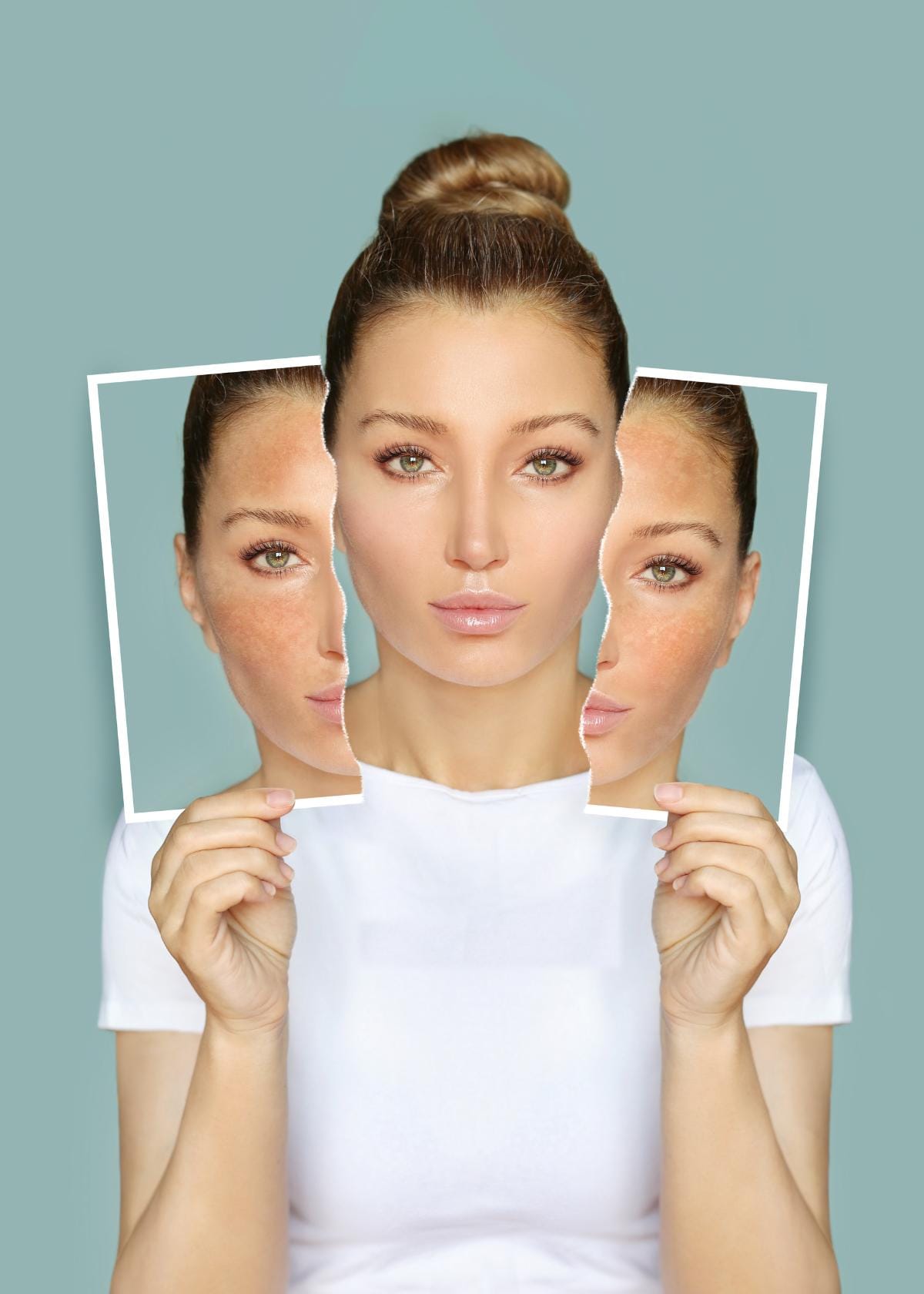Are you troubled by dark spots or uneven skin tone? Hyperpigmentation, a common skin condition often characterized by these symptoms, can negatively impact your confidence.
In this article, we will explore the benefits of glycolic acid - a powerful exfoliant known to effectively treat hyperpigmentation.
Let's unveil how this wonder ingredient may be your ticket to clearer, more radiant skin!
Understanding Hyperpigmentation

Hyperpigmentation is a common skin condition characterized by patches of darkened skin, caused by an excess production of melanin.
What Is Hyperpigmentation?
Hyperpigmentation appears as dark patches on the skin caused by an excess production of melanin, which is the pigment responsible for skin color. This condition can be triggered by various factors like sun exposure, hormonal changes, aging, and even injuries to the skin.
Hyperpigmentation can occur in different forms, such as melasma (large brown patches), sun spots (smaller, darker areas), and post-inflammatory hyperpigmentation (resulting from injury or inflammation).
It's a common issue that affects people across all skin types and colors. Using appropriate skincare products like ones containing glycolic acid can help address this problem effectively.
Causes of Hyperpigmentation
Hyperpigmentation can be caused by several factors, including:
- Excessive sun exposure: The harmful UV rays from the sun can trigger an increase in melanin production, leading to dark spots and uneven skin tone.
- Hormonal changes: Pregnancy, hormonal fluctuations, and certain medications can stimulate melanin production, resulting in melasma or a "mask of pregnancy."
- Post-inflammatory hyperpigmentation: Skin inflammation caused by acne, eczema, or other skin conditions can leave behind dark spots that take time to fade.
- Age: As we age, our skin's natural ability to repair itself slows down, making it more prone to developing areas of hyperpigmentation.
- Genetics: Some individuals are genetically predisposed to developing hyperpigmentation due to their skin type and melanin production.
- Skin trauma: Injuries such as cuts, burns, or surgeries can cause melanocytes (cells responsible for producing melanin) to become overactive and produce excess pigment.
The Role of Glycolic Acid

Glycolic acid, a type of alpha hydroxy acid (AHA), plays a crucial role in treating hyperpigmentation by effectively exfoliating the skin and reducing melanin production.
What Is Glycolic Acid?
Glycolic acid is a type of alpha-hydroxy acid (AHA) that is commonly used in skincare products. It is derived from sugar cane and has exfoliating properties, which means it helps to remove dead skin cells from the surface of the skin.
This makes glycolic acid an effective ingredient for treating various skin concerns, including hyperpigmentation. When applied topically, glycolic acid works by penetrating the outer layer of the skin and promoting cell turnover, helping to fade dark spots and improve overall skin tone.
How Does Glycolic Acid Help with Hyperpigmentation?
Glycolic acid helps with hyperpigmentation by effectively fading dark spots and evening out skin tone. This powerful ingredient works by exfoliating the surface of the skin, promoting cell turnover, and reducing melanin production.
Regular use of glycolic acid can help to gradually fade hyperpigmentation, such as sun spots, melasma, and post-inflammatory hyperpigmentation. It is important to use glycolic acid properly and consistently for best results, as overuse can lead to potential skin problems.
However, when used correctly, glycolic acid can be an effective remedy for hyperpigmentation and contribute to a more even complexion.
Effects of Glycolic Acid on Dark Spots
Glycolic acid has been found to have significant effects on dark spots and hyperpigmentation. Regular use of glycolic acid with salicylic acid can effectively fade these spots over time, resulting in a more even skin tone. Glycolic acid removes the dark spots completely.
By exfoliating the skin and promoting cell turnover, glycolic acid helps to reduce the appearance of discoloration and lightens dark spots. It is particularly effective in reducing sun spots, melasma, and post-inflammatory hyperpigmentation.
However, it is important to use glycolic acid cautiously, as overuse can lead to potential skin problems. Overall, incorporating glycolic acid into your skincare routine can help diminish the visibility of dark spots and achieve a clearer complexion.
Benefits of Glycolic Acid for Hyperpigmentation

Glycolic acid offers numerous benefits for treating hyperpigmentation, including exfoliation and skin renewal, reduction of melanin production, and improved skin hydration.
Exfoliation and Skin Renewal
Glycolic acid is well-known for its exfoliating properties, making it a valuable ingredient for skin renewal. By gently removing dead skin cells from the surface of the skin, glycolic acid helps to reveal fresh, new skin underneath.
This process helps to fade hyperpigmentation by promoting cell turnover and encouraging the growth of new, evenly-pigmented skin cells. Regular exfoliation with glycolic acid can lead to improved texture and tone, giving you a smoother and more radiant complexion.
Reduction of Melanin Production
Glycolic acid helps with hyperpigmentation by reducing melanin production. Melanin is the pigment responsible for giving color to our skin, hair, and eyes. When there is an overproduction of melanin in certain areas, it can lead to hyperpigmentation.
Glycolic acid works by inhibiting the enzyme tyrosinase, which plays a key role in the production of melanin. By reducing this enzyme activity, glycolic acid helps to fade dark spots and even out skin tone.
Regular use of glycolic acid can help to gradually reduce melanin production and improve the appearance of hyperpigmentation over time.
Improved Skin Hydration
Glycolic acid not only helps with reducing hyperpigmentation, but it also has the benefit of improving skin hydration. By exfoliating the outer layer of dead skin cells, glycolic acid allows moisturizers and other hydrating products to penetrate more effectively into the skin.
This helps to lock in moisture and keep the skin hydrated for longer periods, resulting in a smoother and plumper appearance. Moreover, regular use of glycolic acid can stimulate collagen production, which further enhances the skin's ability to retain moisture.
So if you're looking for a way to fade dark spots while also improving your skin's hydration levels, incorporating glycolic acid into your skincare routine may be beneficial.
How to Use Glycolic Acid for Hyperpigmentation?

To use glycolic acid for hyperpigmentation, apply it to clean skin and leave it on for the recommended time before rinsing off. Start with a lower concentration and gradually increase if tolerated well.
Don't forget to follow up with sunscreen. Read more to discover the best ways to incorporate glycolic acid into your hyperpigmentation skincare routine.
Frequency and Application
To effectively use glycolic acid for hyperpigmentation, it is recommended to incorporate it into your skincare routine a few times a week. Apply a thin and even layer of the glycolic acid product onto clean, dry skin.
Usually, dermatologists recommend glycolic acid peels containing ingredients like alpha hydroxy acids to treat age spots, acne-prone skin, and dead cells for a brighter complexion.
Allow the product to sit on the skin for about 5-10 minutes before rinsing it off with warm water. Remember to always follow up with moisturizer and sunscreen after using glycolic acid to protect your skin from potential irritation and sun damage.
With consistent use over time, glycolic acid can help fade hyperpigmentation, resulting in a more even and radiant complexion.
Potential Side Effects
Glycolic acid, like any skincare product, can have potential side effects. It's important to be aware of these before incorporating glycolic acid into your skincare routine. Here are some potential side effects:
- Skin irritation: Some individuals may experience redness, itching, or a stinging sensation when using glycolic acid. This can be more common for those with sensitive skin.
- Dryness: Glycolic acid exfoliates the skin by removing dead skin cells, which can lead to dryness. It is important to moisturize after using glycolic acid to help maintain the skin's hydration.
- Sun sensitivity: Glycolic acid can increase the skin's sensitivity to the sun. It is crucial to use sunscreen daily and avoid prolonged sun exposure while using glycolic acid.
- Increased acne initially: In some cases, glycolic acid may cause a temporary increase in breakouts during the first few weeks of use as it purges impurities from the pores.
- Discoloration: When used incorrectly or in high concentrations, glycolic acid can potentially cause irritation and discoloration on the skin.
- Peeling or flaking: If overused or used too frequently, glycolic acid may cause excessive peeling or flaking of the skin.
- Allergic reactions: Although rare, some individuals may experience an allergic reaction to glycolic acid resulting in symptoms such as rash, hives, or swelling.
Frequently Asked Questions
The following FAQs provide detailed information on the efficacy and proper use of glycolic acid for treating different types of hyperpigmentation.
Read on for research-backed answers on how glycolic acid works on pigmented skin, effective concentrations to use, how to combine it with other actives, and more.
How does glycolic acid help with hyperpigmentation?
Glycolic acid helps with hyperpigmentation by exfoliating the outer layer of skin, reducing the appearance of dark spots and uneven skin tone. It also helps in stimulating collagen production and prevent excess melanin production to offer glowing skin. You should add it to your skincare ingredients.
Can I use glycolic acid on all types of hyperpigmentation?
Yes, glycolic acid can be used on various types of hyperpigmentation, including sunspots, acne scars, and melasma.
How often should I use glycolic acid for it to be effective?
To see results, it is recommended to use glycolic acid products consistently as part of your skincare routine, starting with a lower concentration and gradually increasing frequency over time.
Are there any side effects from using glycolic acid for hyperpigmentation?
Possible side effects from using glycolic acid include redness, dryness, or mild irritation. It's important to follow product instructions and consult with a dermatologist if you experience severe reactions.
Conclusion
Glycolic acid is an effective ingredient for reducing hyperpigmentation and achieving a more even skin tone. By consistently using glycolic acid a few times a week, dark spots caused by sun damage, melasma, and post-inflammatory hyperpigmentation can fade over time.
Additionally, proper use of glycolic acid as an exfoliating agent can help lighten discoloration and even out skin tone. So yes, glycolic acid does help with hyperpigmentation.



